Embracing the Cycle of Life and Death at Varanasi’s Sacred Ground
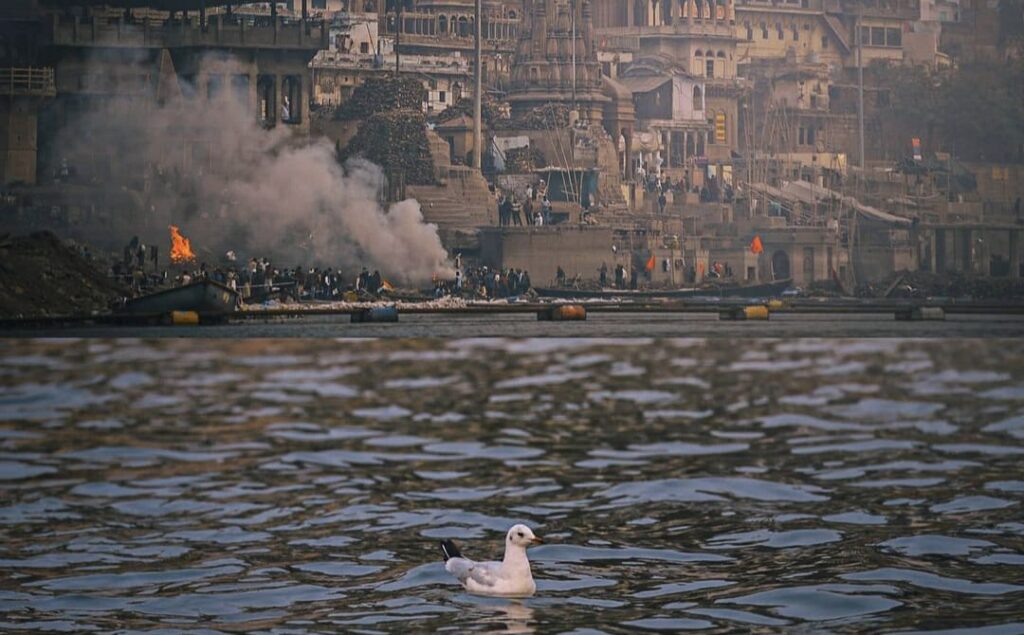
Varanasi, often regarded as one of the holiest cities in India, stands as a beacon of spiritual reverence on the banks of the Ganges River. Within its ancient streets and along its sacred waters lies Manikarnika Ghat, a place where life and death meet, merge, and transcend into the ethereal. This ghat, steeped in mythology and tradition, serves as a powerful reminder of life’s ephemeral nature and the eternal journey of the soul.
The Sanctity of Manikarnika Ghat
Manikarnika Ghat is one of the oldest and most significant cremation grounds in Varanasi. According to Hindu mythology, it is believed that the ghat was established by Lord Vishnu, making it a sacred site for the performance of the last rites. The name “Manikarnika” itself is derived from the legend of Goddess Parvati losing her earring (Manikarnika) at this very spot while bathing with Lord Shiva. Consequently, the ghat is imbued with divine presence and is seen as a gateway to moksha (liberation from the cycle of rebirth).
A Day at Manikarnika Ghat
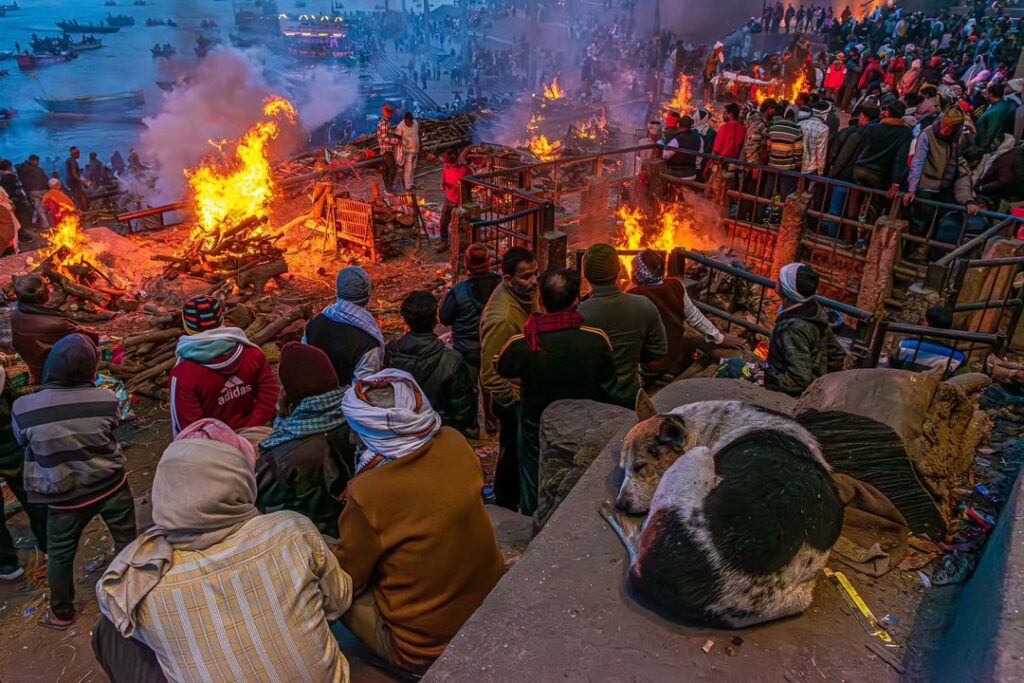
As dawn breaks over Varanasi, the ghat awakens to the sounds of bells, chants, and the rhythmic flow of the Ganges. The air is thick with incense and the poignant aroma of burning wood. Pyres are constructed meticulously, each a solemn testament to a life lived. Families gather around, performing rituals that ensure the departed soul’s peaceful transition to the next realm.
Amidst the sombre rituals, the ghat is a place of paradoxical vitality. The Ganges, ever-flowing and life-sustaining, juxtaposes the stark reality of death occurring on its banks. This coexistence of life and death is not seen as a contradiction but rather as an integral part of the spiritual fabric of Varanasi.
The Philosophy of Life and Death
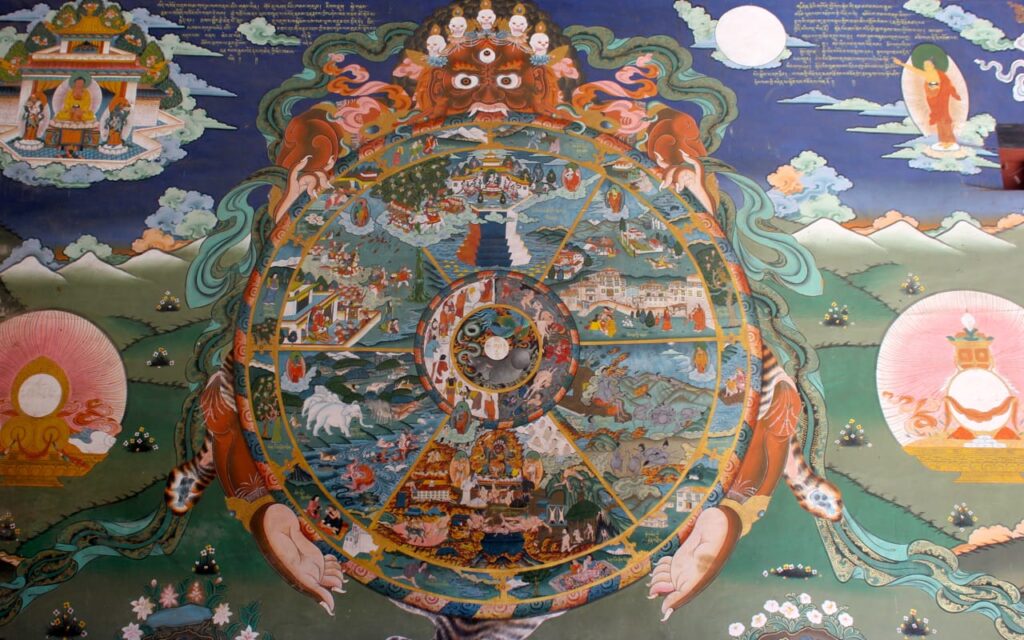
To the uninitiated, the scene at Manikarnika Ghat might seem morbid or disconcerting. However, within the context of Hindu philosophy, the ghat serves as a profound teacher of life’s transient nature. The concept of samsara, the cycle of life, death, and rebirth, is vividly illustrated here. Death is not an end but a transformation, a passage into another state of being.
The act of cremation is rich with symbolism. Fire signifies the purification process and the liberation of the soul from its corporeal form. When the body is reduced to ashes and given to the Ganges, it symbolizes the disintegration of the physical self and its merger with the cosmic entirety. This ceremony serves as a profound reflection on the fleeting nature of our existence within the infinite span of the cosmos.
The Living and the Dead
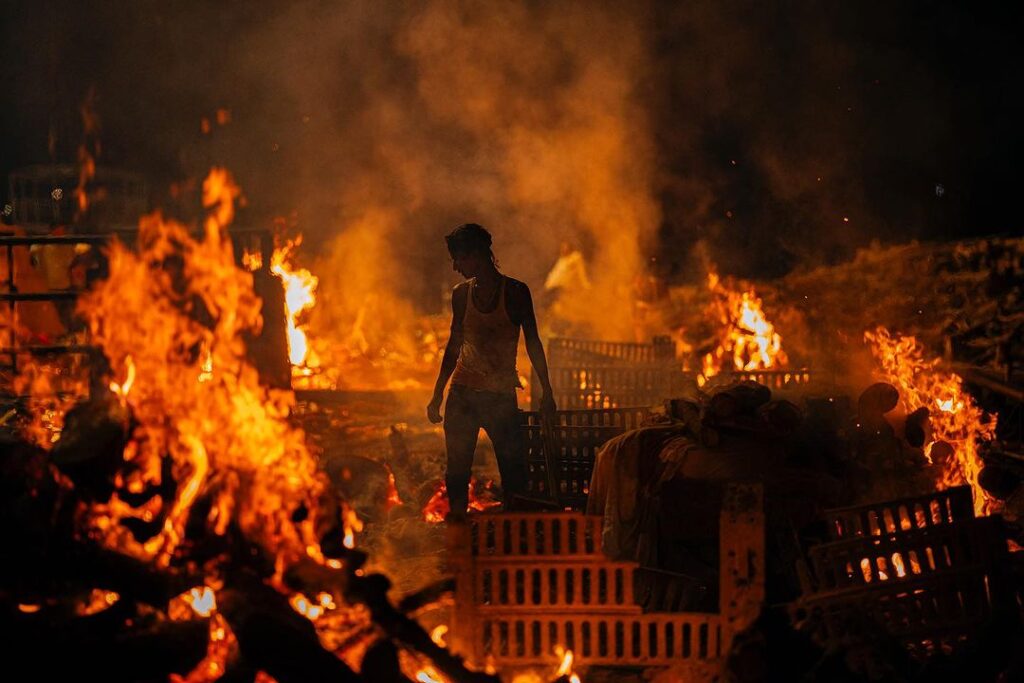
Manikarnika Ghat is not only a site for the departed but also a place where the living confront their mortality. Pilgrims and tourists, sages and scholars, all come to this sacred ground to seek solace, enlightenment, and a deeper understanding of existence. The presence of death is a stark but necessary teacher, urging one to reflect on life’s impermanence and the importance of spiritual pursuits.
For the doms, the caste traditionally responsible for cremations at the ghat, this place is not just a workplace but a spiritual arena where they perform their dharma (duty). Their role, though frequently misunderstood, is crucial in the cycle of life and death. Through their hands, the flames of Manikarnika Ghat burn continuously, a ceaseless reminder of the inevitable end that awaits all beings.
The Pilgrim’s Path
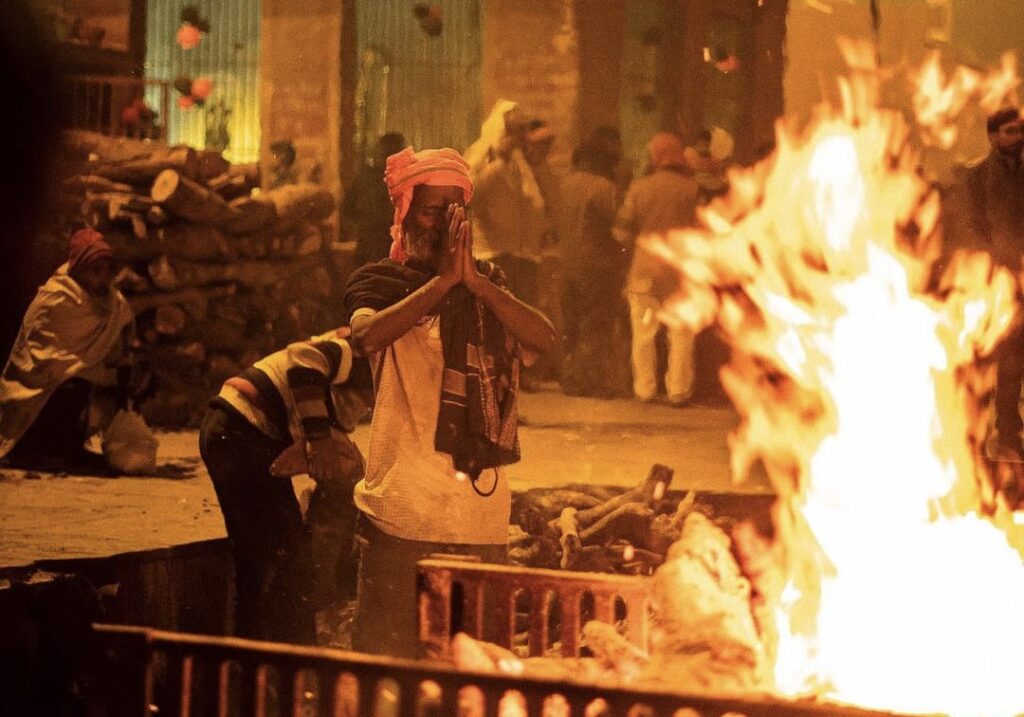
Walking along the ghats of Varanasi, one encounters a myriad of spiritual seekers, each drawn by the magnetic pull of the sacred city. Among them was Ravi, a young man disillusioned with the material world and in search of deeper meaning. Ravi’s journey to Varanasi was not just a physical pilgrimage but a quest for spiritual awakening.
Arriving at Manikarnika Ghat, Ravi was initially overwhelmed by the stark confrontation with death. The pyres, the chants, and the pervasive presence of mortality were unlike anything he had ever experienced. Yet, as days turned into weeks, he began to see beyond the surface. The ghat, perpetually engulfed in the cycle of cremations, mirrored the ephemeral essence of his existence.
In conversations with the locals, sages, and the doms, Ravi learned about the intricate philosophies that underpin the Hindu view of life and death. He participated in the rituals and observed the meticulous rites, and slowly, a transformation began within him. The initial fear and discomfort gave way to acceptance and peace.
Reflections on Mortality
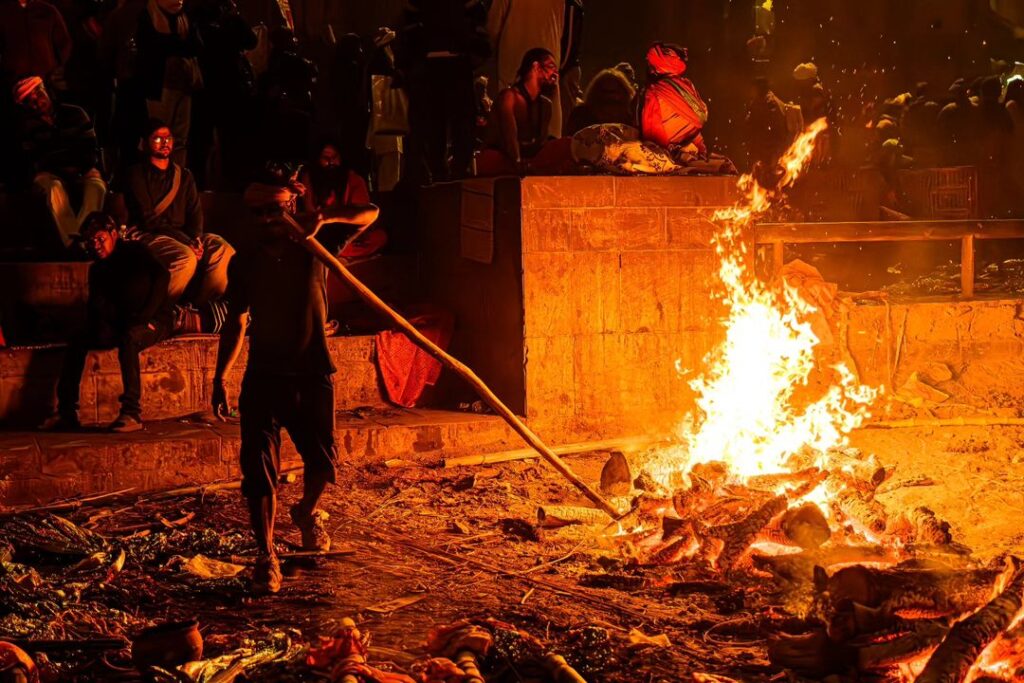
Ravi’s experiences at Manikarnika Ghat led to deep realizations. He understood that the fear of death is frequently rooted in a strong attachment to the material world and an insufficient grasp of the spiritual path. Observing the never-ending cycle of life and death, he learned to value the importance of leading a life based on dharma and spiritual consciousness.
The ghat revealed to him that death is not a cessation but a return to the origin, a merging with the divine. This epiphany dispelled his fears and imbued him with a feeling of freedom. He came to realize that the true meaning of life is to rise above the ego and the corporeal self and to nurture a bond with the everlasting soul.
The Eternal Flame
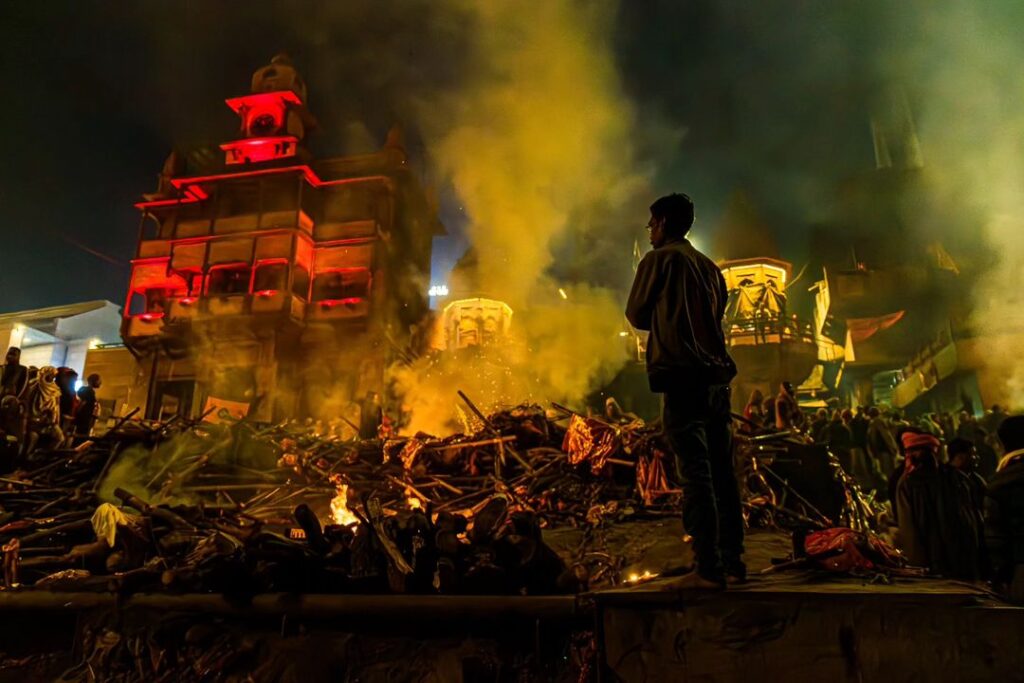
Manikarnika Ghat, known for its eternally burning pyres, is a powerful symbol of the soul’s immortality. The ceaseless flames represent the enduring spirit and the endless cycle of birth and demise. To those who journey to Varanasi for spiritual enlightenment, the ghat imparts deep insights into the transient nature of existence, the importance of non-attachment, and the soul’s final release from the cycle of life and death.
Ultimately, Manikarnika Ghat transcends its role as a cremation site; it stands as a hallowed ground revealing the profound verities of life. This ghat, steeped in enduring sagacity, compels us to acknowledge the transitory aspect of life and to pursue the everlasting amidst the transient.
As Ravi left Varanasi, he carried with him the profound teachings of Manikarnika Ghat. He had come seeking answers and found a deeper understanding of life’s purpose. The ghat had shown him that in accepting death, one truly learns to live. It is a place where life and death dance in eternal harmony, reminding all who visit that the soul’s journey is infinite, and the flames of Manikarnika will forever guide it toward liberation.
Write with us✍?
TeamUgtWorld warmly welcomes everyone! If you have something on your mind that you’d like to write about, we invite you to publish your thoughts on our platform @Ugtworld. To learn more, please click on the link provided below.


